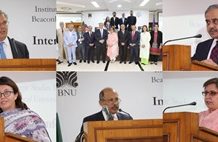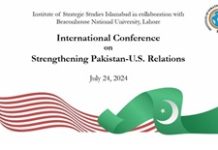China is constructing the world economy. The focus is on ‘shared destiny of all mankind’. In this sense, Chinese President Xi Jinping came forward with an initiative called ‘One Belt-One Road’ policy. It is a hallmark of President Xi’s policy. The idea was floated by him in 2013 during his visit to Kazakhstan and Premier Li Keqiang during his visit to Indonesia the same year also talked about this initiative.
On 28 March, Chinese National Development and Reform Commission, the Ministry of Foreign Affairs, and the Ministry of Commerce unveiled the details of ‘One Belt-One Road’ initiatives under which several corridors will be built to boost regional economies to the tune of US$2.5 trillion benefiting over 4.4 billion population across 65 countries.
The initiative is not simply building roads, rails, and ports but introduces a comprehensive network of infrastructure development. Asia Infrastructure and Investment Bank (AIIB) will finance projects built under this initiative. The BRICS New Development Bank, the Silk Road Fund, as well as China-ASEAN Interbank Association, and SCO Interbank Association will also offer funds.
China wishes that the United States, Europe, and Japan should join this initiative. Some anticipate that the One Belt-One Road initiative is a competitor to the US-led initiative called the Trans-Pacific Partnership (TPP). The One Belt-One Road initiative is not inclusive. It is open to all.
These corridors will be as under: The Maritime Silk Road will connect the Pacific coast to the Baltic Sea. The Silk Road Economic Belt will link China, Central Asia, Russia, and Europe, connecting China with the Persian Gulf, South East Asia and the Indian Ocean with Guangxi Zhuang Autonomous Region and Yunnan as starting points. The land Corridor between China-Mongolia-Russia will be built with Chinese province Heilongjiang as starting point. Starting from Kolkata, the China-India-Bangladesh-Myanmar Corridor will be built. The China-Central Asia-West Asia Corridor will be built with Xinjiang as a starting point. An exclusive China-Pakistan Economic Corridor (CPEC) will be built to connect Gwadar with Xinjiang.
After the Japanese miracle, the Han River miracle, the ASEAN miracle, and the Yellow River miracle, the Indus River miracle too will take place with Chinese support. The process has been started.
Pakistan is an important pillar of China’s ’One Belt-One Road’ initiative. Chinese President Xi Jinping will pay a two-day visit to Pakistan in April. He will meet the President, Prime Minister, Army Chief, Chairman Joint Chiefs of Staff, and leaders of political parties.
President Xi will formally inaugurate the China-Pakistan Economic Corridor (CPEC). President Xi was scheduled to visit Pakistan in September last but postponed the visit following sit-ins protests at Islamabad. The visit of President Xi has been taking place after nine years. Earlier, President Hu Jintao visited Pakistan in November 2006.
With regards to the CPEC, the groundbreaking ceremony will be kicked off by signing a number of agreements when President Xi arrives in Pakistan. As a number of Chinese workers will be deployed on projects in Pakistan, a special security force comprising 12,000 security personnel will be set up by Pakistan to prevent terrorist attacks stemming from the deteriorating security situation in the Middle East and internal law and order.
According to the IMF, Direction of Trade Statistics, Pakistan exports to China were recorded at US$ 2.9 billion in 2013, while imports from China were recorded US$ 12.1 billion for the same period, thus making the two-way trade to US$ 15 billion. China has become Pakistan’s largest trading partner. The increased level of bilateral trade is the result of the Free Trade Agreement (FTA) signed in 2006 and operationalized in 2007. Trade stood around US$ 7.2 billion in 2007, which was just doubled in 2013. Bilateral trade was hardly recorded at US$ 1 billion in 2002. Under the CPEC trade volume would tremendously increase.
China used to be a shy away investor of Pakistan’s Foreign Direct Investment (FDI). However, it made a breakthrough in 2007 when its FDI increased to US$ 712 million, making it the third largest investor in Pakistan. In preceding years, Chinese FDI decreased once again and by investing US$ 700.3 million in 2014, China became the largest FDI partner of Pakistan. This is the result of CPEC initiatives and as Pakistan’s economic outlook was ranked positive by international rating agencies such as Poor’s and Standard, Moody’s, and Japan External Trade Organization (JETRO).
China pledged US$ 46 billion under the CPEC during Prime Minister Nawaz Sharif’s visit to Beijing undertaken in November last. Both sides inked as many as 19 agreements. China also signed 14 agreements to build power plants in Pakistan to generate 10,400 MW electricity in Pakistan. China’s largest hydropower company, Three Gorges, planned to sign agreements worth US$ 15 billion to construct nuclear power plants in Karachi. The company also built Pakistan’s first wind form at Jhimpir, Thatta. Pakistan also plans to import 4000 MW electricity from China. Pakistan is fast becoming an attractive place fetching Chinese investment. The visit of President Xi should be seen within this context of increasing economic and commercial interactions between the two countries.
Views expressed are of the author and do not necessarily reflect the views of ISS or of the Government of Pakistan.













